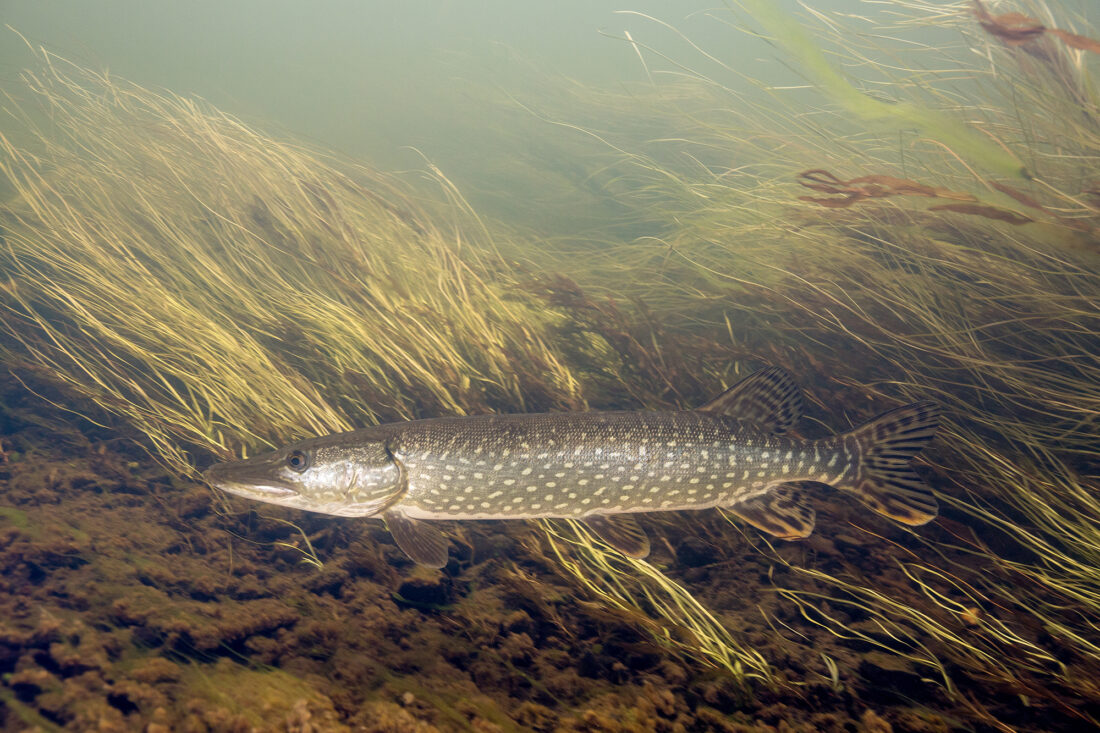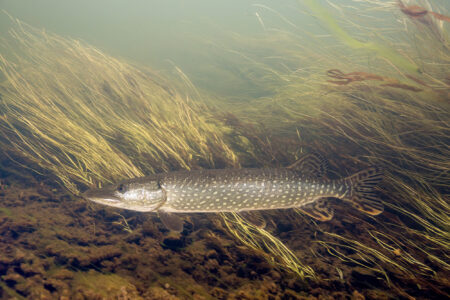Researchers say climate change shrinking fish

Researchers say today’s northern pike are several inches shorter than their ancestors in Michigan lakes. (Photo by Ryan Hagerty/U.S. Fish and Wildlife Service)
(This story was originally published by Bridge Michigan, a nonprofit and nonpartisan news organization. Visit the newsroom online: bridgemi.com.)
In addition to shorter ski seasons, worsening ticks and allergies and shrinking boreal forests, climate change has hit the Great Lakes State in another way: shrinking fish.
That’s according to new research stemming from a massive crowdsourced effort to digitize decades-old scientific observations written on notecards by scientists with what’s now known as the Michigan Department of Natural Resources.
Subsequent modeling by University of Michigan and DNR scientists aligned the observations in that database with long-term temperature models, revealing that successive generations of fish are growing smaller in response to warming waters and longer summer seasons.
The findings were published this month in the journal Global Change Biology.
Researchers tracked changes in fish sizes through varying age classes, attempting to discern not just whether fish sizes have changed but which fish — from the youngest juveniles to the oldest adults — felt the impacts the most.
Northern pike is among the most deeply affected of 13 species studied.
The large, toothy carnivores shrank across every life stage at average rates of between half-a-millimeter and nearly 4 millimeters annually. Add that up over decades, and today’s pike are several inches smaller than they would be in a stable climate.
The shrinking trend is troubling for a number of reasons.
For one, smaller fish tend to be more vulnerable to predation and produce fewer offspring.
And, from a human perspective, they’re a less desirable catch.
“When people think about climate change, you might think about carbon, you might think about your car, maybe you even think about your diet,” said Peter Flood, a postdoctoral research fellow with the U-M School for Environment and Sustainability who was among several researchers on the project. “But a lot of people don’t think about how that might impact their fishing trip.”
The findings add to a growing body of research showing how fossil fuel consumption and resulting greenhouse gas emissions are fundamentally altering Earth’s climate.
A 2022 study in the journal Ecosphere concluded that, by mid-century, more than half of Michigan’s 300 high-quality coldwater lakes will no longer be categorized as such. Same goes for the vast majority of Michigan’s coldwater rivers.
Already, “we’re seeing loss of coldwater fisheries, in part attributable to climate change,” DNR Fisheries Resource Analyst Joe Nohner said.
For example, Nohner said, warming water plays a role in ongoing cisco population declines and faltering walleye reproduction rates.
Concerned about the warming trend, state and tribal environmental agencies will soon launch an initiative to boost water quality and habitat on selected northern Michigan lakes in hopes of bolstering them against the coming changes.
The research into shrinking fish relied on a trove of historical records housed at the Institute for Fisheries Research in Ann Arbor. Since at least the 1920s, state scientists have taken frequent notes on the fish found in lakes across the state.
But their handwritten records had been “more or less sitting in a cabinet or on a shelf for decades,” Flood said.
Researchers saw an opportunity to transcribe the notes into a long-term dataset that could reveal how Michigan’s fish have changed over time. For help, they turned to Zooniverse, a website that allows volunteers from around the world to collaborate on scientific research.
The resulting data showed clear connections between smaller fish, warmer water temperature and longer growing seasons. Both coldwater- and warmer water-loving fish were affected, but potentially for different reasons.
Take, for instance, perch, a fish that prefers water temperatures between 66 degrees and 70 degrees. Young and elderly perch shrank over time, while middle-aged fish maintained steadier sizing.
“That might be the product of those reproductive adults having more offspring because they are doing well in the warm water,” Flood said.
In lakes with limited food, more mouths to feed may have resulted in shortages that stunted growth.
Coldwater fish responded differently. Warmer water temperatures generally meant bad news for them, regardless of the age class.
The next step in the research is better understanding what mechanisms are driving the relationship between warmer temperatures and reduced fish growth, said Kevin Wherly, a fishery research biologist with the DNR.
“That information will be important in developing management strategies going forward,” Wherly said.





